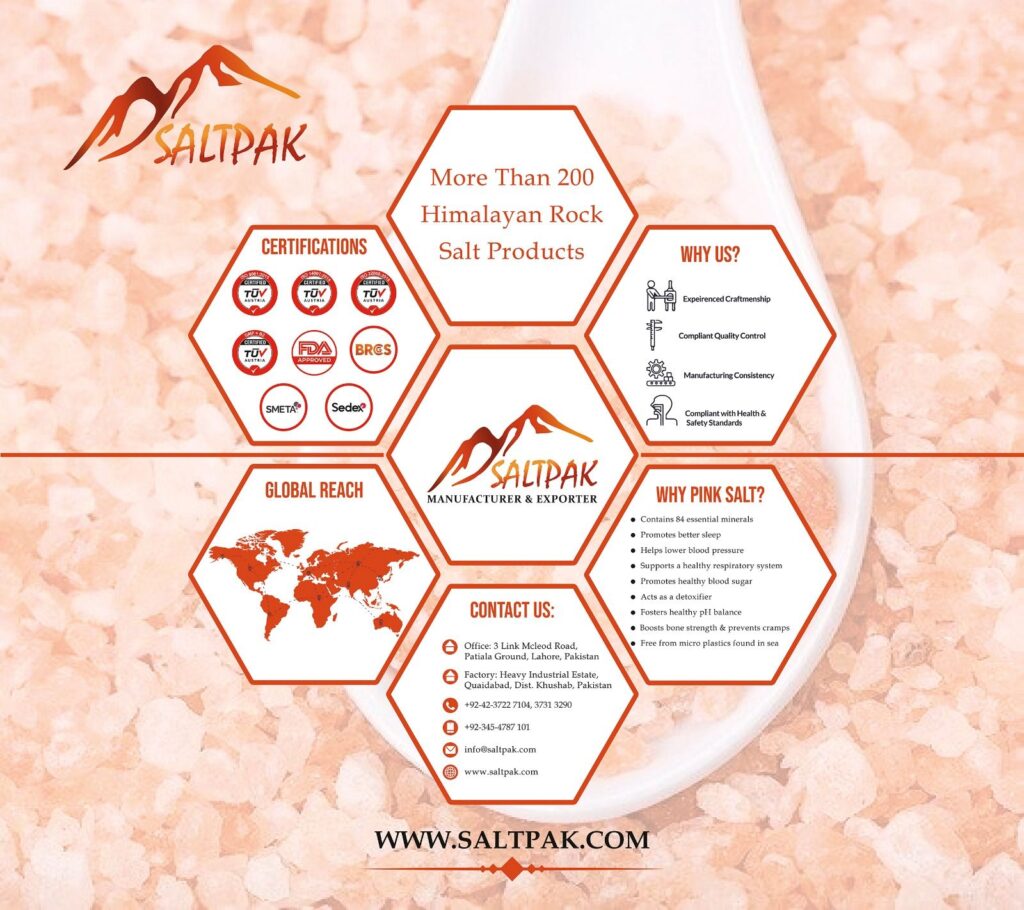Himalayan salt, often referred to as “pink gold,” is prized for its unique color, mineral content, and purported health benefits. However, the popularity of this natural salt causes many counterfeit products of it in the market. So, it has become quite a difficult task to differentiate between authentic and fake Himalayan salt products. With this perspective in mind, we have brought a blog for you all so that it would be easy for you to differentiate among them.
We all know what Himalayan salt is? Basically, it is a type of rock salt that comes from the Khewra Salt Mine in Pakistan. It is called Himalayan salt because khewra mines are located near the Himalayan Mountains.
Key Characteristics of Authentic Himalayan Salt:
The key characteristics of authentic and real Himalayan salt are these.
- Color: Authentic Himalayan salt color ranges from light pink to deep reddish-pink.
- Texture: The texture of a real Himalayan salt can vary, it can be coarse or fine, depending on processing.
- Mineral Content: The main property is that this salt contains 80+ trace minerals, giving it a unique flavor and color.
Why Authenticity Matters?
You need to know the difference between real and fake Himalayan salt products. Actual Himalayan salt not only provides the expected health benefits but also ensures that you’re supporting ethical mining practices. Counterfeit products may contain additives or contaminants, lack the full range of minerals, and contribute to unsustainable mining practices.
Spotting Fake Himalayan Salt: A Step-by-Step Guide
1. Check the Color:
The first thing that differentiates between these two is the color of Himalayan salt.
Authentic Himalayan Salt:
- Color Range: Authentic salt can range from almost white (rare) to pink, reddish, or even orange.
- Consistency: The color should be relatively consistent within each product, though slight variations are natural.
Fake Salt:
- Unnatural Colors: If the salt is overly bright, uniformly white, or contains specks of other colors, it may be dyed or mixed with other salts.
- Inconsistent Color: Drastic color differences within the same product may indicate it’s been mixed with other substances.
2. Examine the Texture
Authentic Himalayan Salt:
- Texture: Real Himalayan salt comes in various textures, from fine to coarse. It should feel slightly rough and irregular if in its natural state.
- Crystalline Structure: The salt crystals should have a natural, non-uniform structure.
Fake Salt:
- Overly Smooth: If the salt feels overly smooth, it may be processed or mixed with additives.
- Uniform Crystals: A uniform, perfect crystalline structure could be a sign of synthetic production.
3. Test the Solubility
Authentic Himalayan Salt:
- Dissolves Slowly: Authentic Himalayan salt dissolves slowly in water. When dissolved, it should leave no residue behind.
Fake Salt:
- Dissolves Quickly: Fake salt often dissolves too quickly, indicating the presence of additives or a different salt type.
- Residue: If it leaves behind a residue, it may not be pure Himalayan salt.
4. Smell the Salt
Authentic Himalayan Salt:
- No Odor: Genuine Himalayan salt should be odorless. It should not have any scent unless mixed with other ingredients (e.g., in spa products).
Fake Salt:
- Chemical Smell: A chemical or artificial smell may indicate that the salt has been treated or is not pure.
5. Verify the Source
Authentic Himalayan Salt:
- Origin: Genuine Himalayan salt is mined in Pakistan, specifically from the Khewra Salt Mine. Check the packaging for this information.
- Certification: Look for certifications or assurances from the seller that the salt is sourced from the Khewra mine.
Fake Salt:
- Lack of Information: If the source is not listed, vague, or mentions a different region, be cautious.
- No Certification: A lack of certification or third-party verification may indicate that the product is not authentic.

6. Inspect the Packaging
Authentic Himalayan Salt:
- Labeling: Check for clear labeling that indicates the salt’s origin and grade.
- Packaging Quality: High-quality packaging with a secure seal is typical for authentic products.
Fake Salt:
- Generic Labeling: Generic labels with terms like “pink salt” without mention of “Himalayan” or the mine of origin are red flags.
- Low-Quality Packaging: Low-quality packaging or inconsistent branding may indicate a counterfeit product.
7. Check the Price
Authentic Himalayan Salt:
- Price Range: Original Himalayan salt is generally more expensive due to the costs associated with mining and importing. Prices that are too low might be suspicious.
Fake Salt:
- Too Cheap: If the price is significantly lower than other Himalayan salt products, it may not be genuine. Cheap imitations often lack the minerals and benefits of real Himalayan salt.
8. Look for Trusted Brands
Authentic Himalayan Salt:
- Reputable Brands: Purchase from well-known, certified and reputable brands that provide clear information about the source and quality of their Himalayan salt.
Fake Salt:
- Unknown Brands: Be cautious with unfamiliar brands, especially if they provide little to no information about their product’s origin.
